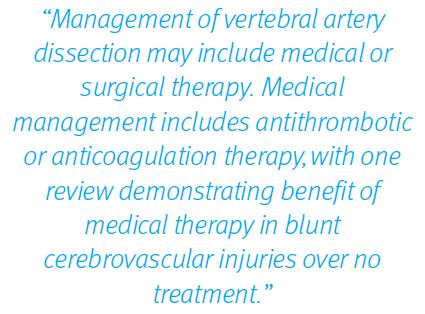Urgent message: Most cases of vertigo are benign. This includes etiologies such as benign paroxysmal position vertigo, labyrinthitis, and psychogenic causes. However, there are serious, “can’t miss” etiologies which should be considered during the urgent care evaluation of a dizzy patient.
Cody McCoy, DO and Michael Weinstock, MD
Citation: McCoy C, Weinstock M. A cause of dizziness not to be missed. J Urgent Care Med. 2023;17(5):13-16.
Key words: dizziness, vertigo, disequilibrium, BPPV
INTRODUCTION
Dizziness presents a challenging complaint to accurately diagnose, not only because of the wide array of potential diagnoses, but also due to the imprecise description of symptoms including “the room spinning” (as is typical for vertigo), light-headedness, presyncope, or disequilibrium.
Vertigo is frequently caused by benign paroxysmal positional vertigo (BPPV) but may be from labyrinthitis following an upper respiratory infection or, more seriously, from a cerebellar or brainstem stroke, mass, or bleed.
Disequilibrium may be present due to a musculoskeletal or cerebellar disorder or in patients with Parkinson’s disease.1 Presyncope occurs when moving from a seated to standing position and may be associated with orthostatic hypotension.2 Psychiatric conditions, such as panic disorder, may be associated with transient lightheadedness, especially when hyperventilation occurs due to the consequent respiratory alkalosis.
BRIEF CLINICAL CASE
An 86-year-old man with a history of hypertension and carotid artery stenosis presented with a chief complaint of imbalance, which he stated was present upon waking that morning and had been constant since. The sensation of imbalance did not change with head movements. No lateralizing neurological symptoms were present, but he did note feeling mild, vague confusion. He specifically denied numbness or weakness of extremities, slurred speech, facial droop, fever, and cough. His medications included hydrochlorothiazide, lisinopril, and atorvastatin.
Physical Examination
Vital signs were normal except for a blood pressure of 155/91. General appearance was normal for age. Lungs were clear bilaterally. Cardiac exam was normal with a regular rate and rhythm without murmur. Neurologic exam revealed normal fluent speech and steady gait, complete cranial nerve function was within normal limits, strength and sensation normal in all four extremities, and coordination testing demonstrated normal finger-to-nose testing symmetric bilaterally.
Differential Diagnosis Considerations and Evaluation
Dizziness is a common but nonspecific complaint and can result from a myriad of etiologies ranging from benign to life-threatening. Dizziness is often broadly categorized into either principally vertiginous or lightheadedness/presyncopal in nature. While simple, this framework can be problematic as patients commonly cannot define the sensation precisely. In fact, when patients are asked about dizziness, their answers regarding “spinning or motion” often change from moment to moment. In one study, when asked to pick the “single best descriptor” for their dizziness, 52% of subjects chose a different response when asked the same question 6 minutes later.3

Differential Diagnosis
While the list of differential diagnoses for dizziness is vast, identifying the clear presence of vertigo based on features of the history (eg, sensation of spinning or movement, associated vomiting) or physical exam (eg, ataxia, nystagmus) narrows the differential considerably.
When considering the possible sources of vertigo, it is useful to understand features which distinguish peripheral nervous system (PNS) pathology from central nervous system (CNS) disease.
The importance of distinguishing peripheral vertigo from central vertigo is highlighted by the more emergent causes of central vertigo, as discussed below. The HINTS exam offers bedside utility to distinguish these two etiologies. The HINTS exam includes the head impulse test, nystagmus test, and test of skew deviation. HINTS exam should be conducted in patients with continuous vertigo, as opposed to those who present with positional vertigo (eg, BPPV).4
The head impulse test is conducted by rotating the patients head laterally by approximately 20°, then rapidly rotating it back towards midline. Catch-up saccades are indicative of peripheral vertigo, while the absence of catch-up saccades indicates a central etiology.
Peripheral vertigo can be suspected with the presence of contralateral, unidirectional nystagmus. Conversely, bidirectional nystagmus is indicative of a central cause.
Test of skew deviation is conducted by covering and then uncovering each eye to assess for the presence of vertical adjustment. Absence of vertical adjustment indicates a peripheral cause, while the presence of vertical adjustment is indicative of central vertigo.
CAUSES OF PERIPHERAL VERTIGO
Benign Paroxysmal Positional Vertigo (BPPV)
The classic presentation of BPPV is a patient who awakens without dizziness, rolls over, and has a sudden onset of vertigo which is intermittent and positional (for example, when rotating their head).
In BPPV, dizziness is not constant. Diagnostic evaluation may include assessment of gait and reproduction of symptoms with Dix-Hallpike maneuver, though neither positive nor negative findings have sufficient sensitivity and specificity to rule in or rule out this diagnosis. An analysis by Halker, et al found a sensitivity of 79% and specificity of 75% for BPPV.5 With consideration of more serious causes, this sensitivity and specificity are not adequate to definitively diagnosis BPPV.
Several factors raised clinical suspicion that this patient’s chief complaint of dizziness was not due to a benign diagnosis such as BPPV.
This patient’s dizziness was not associated with positional change of the head, but was described as constant, not consistent with intermittent dizziness associated with BPPV. Further, this patient described his dizziness as a sense of imbalance that was not associated with vertigo. He represented as a higher risk patient, with a PMH including three-drug hypertension, carotid stenosis, and hypercholesterolemia. Finally, he admitted to not being able to “think clearly” since awakening. BPPV could not be definitively attributed to our patient.
Deep Dive on BPPV
BPPV is the most common cause of vertigo in all clinical settings, including the ED. The condition occurs when otoconia (which normally reside in the utricle) are displaced spontaneously or by trauma or infection into the semicircular canals. As a result, when patients move their head in certain positions, they experience vertigo and nystagmus, sometimes very intense, for less than 2 minutes, often around 20 seconds. BPPV can be diagnosed easily with a bedside test and is highly responsive to treatment with the Epley or other particle repositioning maneuvers.
Vestibular neuritis is the second most common peripheral cause of vertigo. Sometimes erroneously mislabeled as labyrinthitis by some clinicians, the condition is believed to be caused by a deficit in one of the vestibular nerves. The likely cause is a virus. The patient develops a prolonged, continuous bout of vertigo that is intense for several days and then resolves over days, weeks, or months. There is no associated ear pain, hearing loss, or tinnitus in vestibular neuritis.
Labyrinthitis, a complication of acute otitis media, is less common than vestibular neuritis but can present in a similar manner, with days of ongoing, continuous vertigo and nystagmus. Unlike vestibular neuritis, patients with labyrinthitis complain of ear pain, hearing loss, or tinnitus as well as vertigo.
Vestibular neuritis
Vestibular neuritis is thought to be caused by a virus and is a constant vertigo which lasts from days to weeks to months; there is not associated hearing loss, ear pain or tinnitus.6 Our patient had a constant vertigo, making this diagnosis a consideration after initial evaluation, but was not able to be differentiated from a more serious cause such as posterior circulation stroke at the bedside.
Labyrinthitis
Labyrinthitis can cause vertigo, typically preceded by a viral infection; the patient did not complain of preceding fever, rhinorrhea, cough, or myalgias and did not complain of ear pain. This diagnosis was unlikely for our patient.6
Meniere’s disease
Meniere’s disease can cause vertigo but is rare compared with the above causes; it is thought to be due to endolymphatic hydrops (a swelling of the labyrinth of the inner ear) and is characterized by sensorineural hearing loss, a sense of fullness in the ear, and tinnitus; the most useful test is pure tone audiometry.7 This is an unlikely diagnosis for our patient as he did not complain of hearing loss, tinnitus, ear fullness.
CAUSES OF CENTRAL VERTIGO
Cerebellar or Brainstem Mass or Bleed
Posterior circulation stroke/TIA
The most feared cause of vertigo is a posterior circulation stroke, more common in patients with increased risk factors as well as with constant vertigo. Of patients with isolated dizziness (no other associated symptoms of stroke), only 0.7% were from a stroke, more common in men, older patients, and those who complained of imbalance.8
Multiple medications, including beta blockers and diuretics (which the patient had been taking), may cause symptoms of dizziness. The patient’s son, however, also confirmed that the patient seemed confused which would not be expected to be present with BPPV or with a medication-associated cause of dizziness.
Exploring either of these independently could yield a wide differential, but together they raise concern for a posterior circulation event, such as a stroke, mass, or bleed. The patient had a known history of carotid stenosis, increasing suspicion for obstructive etiology such as ischemic cerebrovascular accident or (transient ischemic attack). Other life-threatening causes of dizziness may include arrythmias, CNS infection, and hypoglycemia.3
The patient had an acute onset of symptoms and no history of unintentional weight loss, making mass less likely. The patient was not anticoagulated and there was no history of trauma, making bleed less likely. Posterior circulation stroke remained a possibility, especially with the associated confusion, and the decision was made to send the patient for imaging.

TREATMENT/OUTCOME
Due to these concerns, the patient had an ED evaluation where stroke was considered and a computed tomography angiogram (CTA) of the head and neck was obtained, which revealed a right vertebral artery dissection at the level of C3.
DISCUSSION
Cervical artery dissection describes an intimal tear occurring in either the carotid or vertebral arteries. Vertebral artery dissection represents a rare but potentially life-threatening presentation, with incidence of about 1 per 100,000 individuals.2 Dizziness is the most common symptom at presentation, appearing in 58% of patients, closely followed by headache (51%) and neck pain (46%).9
Reported risk factors for vertebral artery dissection include history of trauma and connective tissue disorders. However, the correlation of these risk factors with development of vertebral artery dissection may not be as strong as previously believed, with one systematic review showing these risk factors were present in only 8% of cases of vertebral artery dissection.9
Digital subtraction angiography (DSA) is traditionally accepted as the gold standard imaging modality for the diagnosis of vertebral artery dissection. Typically, imaging is performed with CTA or magnetic resonance angiography (MRA).10 The most common imaging characteristic associated with vertebral artery dissection is arterial stenosis (51%), followed by “string and pearls” (48%), and dilation of artery (37%).9
Management of vertebral artery dissection may include medical or surgical therapy. Medical management includes antithrombotic or anticoagulation therapy, with one systematic review clearly demonstrating benefit of medical therapy in blunt cerebrovascular injuries over no treatment.11 Further research may determine the efficacy of antithrombotic compared with anticoagulation therapy and the optimal duration of treatment. Case reports have described patients undergoing endovascular stenting, thrombectomy, or a combination of thrombectomy/stenting with success.12
Teaching Points
- Dizziness can be caused by a broad range of benign to life-threatening conditions.
- Suspicion of a concerning etiology should be higher in patients presenting with constant vertigo, which is not associated with positional change of the head or change from seated position, or those with known history of arterial disease such as carotid stenosis.
- The Dix-Hallpike maneuver does not have sufficient sensitivity or specificity to exclude or confirm the diagnosis of BPPV.
- Trauma and connective tissue disorders are significant risk factors for vertebral artery dissection, but do not need to be present for a dissection to occur.
- The absence of abnormal findings on gait and coordination testing does not exclude vertebral artery dissection.
- About half of patients with vertebral artery dissection will have no headache or neck pain.
- Diagnosis of cervical artery dissection can be confirmed with a CT-A of the head and neck.
- Recommendations for vertebral artery dissection may consist of either medical therapy (eg, antiplatelet and/or anticoagulant agents) or surgical interventions depending on patient features and the location and extent of the dissection.
References
- Kwon KY, Park S, Lee M, et al. Dizziness in patients with early stages of Parkinson’s disease: Prevalence, clinical characteristics and implications. Geriatr Gerontol Int. 2020;20(5):443-447.
- Lee VH, Brown RD, Mandrekar JN, Mokri B. Incidence and outcome of cervical artery dissection: a population-based study. Neurology. 2006;67(10):1809-1812.
- Newman-Toker DE, Hsieh YH, Camargo CA Jr, et al. Spectrum of dizziness visits to US emergency departments: cross-sectional analysis from a nationally representative sample. Mayo Clin Proc. 2008;83(7):765-775.
- Dmitriew C, Regis A, Bodunde O, et al. Diagnostic accuracy of the HINTS exam in an emergency department: a retrospective chart review. Acad Emerg Med. 2021;28(4):387-393.
- Halker RB, Barrs DM, Wellik KE, et al. BM. Establishing a diagnosis of benign paroxysmal positional vertigo through the Dix-Hallpike and side-lying maneuvers: a critically appraised topic. Neurologist. 2008;14(3):201-204.
- Muncie HL, Sirmans SM, James E. Dizziness: approach to evaluation and management. Am Fam Physician. 2017;95(3):154-162.
- Harcourt J, Barraclough K, Bronstein AM. Meniere’s disease. BMJ. 2014;349:g6544.
- Kerber KA, Brown DL, Lisabeth LD, et al. Stroke among patients with dizziness, vertigo, and imbalance in the emergency department: a population-based study. Stroke. 2006;37(10):2484-2487.
- Gottesman RF, Sharma P, Robinson KA, et al. Clinical characteristics of symptomatic vertebral artery dissection: a systematic review. Neurologist. 2012;18(5):245-254.
- Shakir HJ, Davies JM, Shallwani H, et al. Carotid and vertebral dissection imaging. Curr Pain Headache Rep. 2016;20(12):68.
- Murphy PB, Severance S, Holler E, et al. Treatment of asymptomatic blunt cerebrovascular injury (BCVI): a systematic review. Trauma Surg Acute Care Open. 2021;6(1):e000668.
- Kondo R, Ishihara S, Uemiya N, et al. Endovascular treatment for acute ischaemic stroke caused by vertebral artery dissection: a report of three cases and literature review. NMC Case Rep J. 2021;8(1):817-825.
Manuscript submitted October 31, 2022; accepted November 5, 2022.
Author affiliations: Cody McCoy, DO, Adena Medical Center. Michael Weinstock, MD, Adena Health System; The Ohio State University Department of Emergency Medicine; Urgent Care Max; Ohio Dominican University Physician Assistant Studies Program; Journal of Urgent Care Medicine. The authors have no relevant financial relationships with any commercial interests.
Read More


